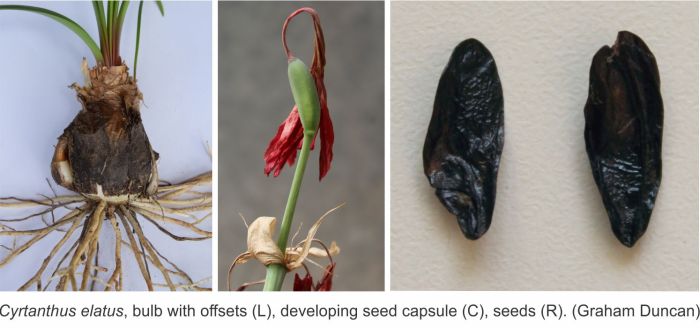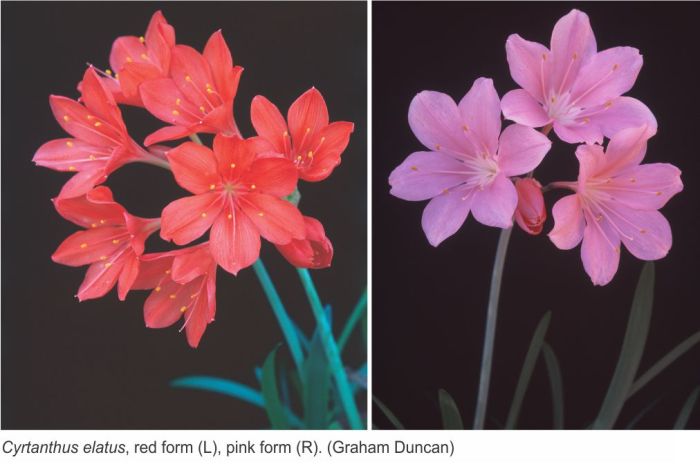Cyrtanthus elatus
Cyrtanthus elatus (Jacq.) Traub
Family: Amaryllidaceae
Common names: George lily, Scarborough lily (Eng.); george-lelie, knysna-lelie (Afr.)
Introduction
Cyrtanthus elatus is a bulbous plant from the fynbos, with spectacular, scarlet, deep red, rose-pink or rarely, white blooms, which appear from late spring to mid-autumn. It is grown world-wide as a long-lived, window sill or patio plant.

Description
Description
This evergreen, summer-growing geophyte reaches 420–650 mm high in flower. It grows from a subterranean or partially exposed, egg-shaped bulb, covered with papery, light brown, outer tunics, produced into a neck, up to 40 mm long. The bulb reproduces by formation of offsets and bulblets. The suberect or arching leaves are broadly strap-shaped, and deep green, and produced in 2 opposite rows (distichous), and have rounded tips. One to several hollow flower stems emerge per bulb. The flower head (umbel) produces 2–10, widely funnel-shaped, slightly irregular (zygomorphic), unscented blooms, each with a long, straight, perianth tube 15–20 mm long, produced on dull green flower stalks (pedicels) 25–60 mm long. The flower stalks are enclosed by 2 membranous spathe bracts, and each flower comprises 6 oblong-oval-shaped, scarlet, deep red, rose-pink or rarely white tepals. The stamens are slightly inwardly curved, and arise in the mouth of the perianth tube. They are arranged in a single row, and have bright yellow, ripe anthers. The style is slightly downwardly curved, and extends shortly beyond the tepal tips. The fruit is an ellipsoid capsule, which, when ripe, splits from the apex downwards, along 3 longitudinal lines. The black, narrowly oval-shaped seeds are surrounded by a black, aerodynamic wing.

Conservation Status
Status
According to the Red List of South African plants website, Cyrtanthus elatus is not threatened, and is assessed as Least Concern (LC), meaning that it is considered at low risk of extinction, because of its generally inaccessible habitat.
Distribution and habitat
Distribution description
Cyrtanthus elatus is known from the southern coastal mountains from just north of Mossel Bay in the Western Cape, to Humansdorp in the southern Eastern Cape. It occurs singly, in small groups, or in colonies, in loamy, acid soils. It favours moist, sandstone mountain slopes, in fynbos, often in association with restios, grasses and ferns, occurring in full sun or light shade. Flowering is much enhanced by periodic fires which sweep through its habitat in summer, during which the leaves are burnt off, but they soon re-appear following autumn rains.

Derivation of name and historical aspects
History
The genus name Cyrtanthus is derived from the Greek kyrtos (curved), and anthos (flower), with reference to the curved perianth, seen in certain members of the genus. The Latin specific name elatus describes the elevated manner in which the flower head is held well above the leaves.
The Swede, C.P. Thunberg, and the Scot, Francis Masson, first recorded a red form of this species in the Outeniqua Mountains north of Mossel Bay, in late 1773, and it was introduced into cultivation at the Royal Botanic Gardens, Kew, by Masson, in 1774. In 1782, Linnaeus the Younger described it as Crinum speciosum, a name ultimately placed in synonymy, and in 1797, the Dutch-born scientist, Nikolaus Joseph von Jacquin, described and illustrated it as Amaryllis elata in volume 1 of Plantarum rariorum horti caesarei Schoenbrunnensis descriptions et icones, from plants grown at the Imperial Gardens near Vienna. An earlier painting had, however, been done by the Dutch naturalist Robert Gordon, either before, or during, one of his four expeditions to the Cape, between 1777 and 1786, and is housed in the Rijksmuseum in Amsterdam. The plant subsequently became known under many names, including Amaryllis speciosa and Amaryllis purpurea, both in 1789, and in 1821, the British botanist William Herbert established the genus Vallota especially for it, naming it V. purpurea, following which it became Vallota speciosa in 1894. In 1963 it became Cyrtanthus purpureus, and its current name (Cyrtanthus elatus), was finally adopted for it by the American botanist, H.P. Traub, in the journal Plant Life, in 1969. However, the plant is still generally known as Vallota purpurea or V. speciosa in the horticultural trade. Among several vernacular names, it became popularly known as the Scarborough lily, although it is not precisely known how this came about. The plant has the largest flowers of all Cyrtanthus species, and has been in continuous cultivation for almost two-and-a-half centuries, as an indoor plant in cold climates, and as a patio and bedding subject in temperate parts.
With well over 50 members, Cyrtanthus is the most species-rich genus of the southern African Amaryllidaceae. It is concentrated in South Africa in the southeastern part of the Eastern Cape. C. breviflorus, the yellow fire-lily, is the most widespread one, occurring from the Eastern Cape to East Africa, and the Democratic Republic of Congo. C. elatus is the most important member in world horticulture, both as a container plant, and, to a lesser extent, as a cut flower. It is also an excellent parent in the development of hybrids, notably with C. montanus. A number of other cyrtanthus are widely grown as container and bedding plants, including C. brachyscyphus, C. mackenii and C. sanguineus.

Ecology
Ecology
Cyrtanthus elatus is an evergreen plant, producing new leaves mainly in summer, while simultaneously losing several of its oldest, outermost ones. Mature bulbs produce bulblets beneath the outer bulb tunics, which detach and become independent plants. Like many other members of the Amaryllidaceae, the bulbs contain toxic alkaloids, including haemanthamine and zephyranthine. The striking, bright red or scarlet flowers are pollinated by the large, brown-and-yellow Table Mountain beauty butterfly (Aeropetes tulbaghia). When ripe, the seed capsules split lengthwise along 3 longitudinal lines, from the tip downwards. The light, ripe seeds are aerodynamic, furnished with a papery black wing, and are dispersed by the shaking action of wind, landing some distance away from the mother plant. Flowering takes place in the wild from late spring to mid-autumn (October to April).
Uses
Use
Cyrtanthus elatus has no traditional or magical uses, but it is widely used as a container subject by gardeners and specialist bulb growers, and sometimes by cut flower producers.

Growing Cyrtanthus elatus
Grow
Cyrtanthus elatus is highly recommended for containers, placed on a window sill or patio, and also performs well as a bedding plant, in a sheltered but well-ventilated, frost-free environment. It likes full morning sun and afternoon shade, but will also do well in light shade throughout the day. Grow the plants in an acid or neutral growing medium that drains well, such as equal parts of loam, finely sifted, acid compost and coarse grit or river sand. Plant mature bulbs in deep, 25 cm or 30 cm diam. pots in spring, with the bulb necks exposed. In cold climates, terracotta pots are most suitable, but in warm parts, plastic pots are preferable. Provide an initial heavy watering in late spring, at the start of the growing period, and repeat once per week for the duration of summer, or as needed, allowing the growing medium to dry out partially between applications of water.
Cyrtanthus elatus comprises distinct growth forms among the scarlet- and red-flowered forms, including some which increase vegetatively by offsets and bulblets at a rapid rate, but flower erratically, whereas others are less inclined to multiply, but flower every year. Pink forms are relatively rare in cultivation, but as easily grown as red and scarlet forms, and white forms are very rare, and not as robust.
Propagation by offsets is the most feasible way of maintaining material that is exactly true to type, and offsets are best separated from the mother bulbs and replanted in spring. Propagation by seed is an alternative method, however, hand-pollination is required. Pollinate the flowers of different clones by collecting ripe pollen (it should be dry and easily removed) from the anthers with a water-paint brush, then dab the brush onto the stigmas of different individuals. Harvest the seeds as soon as the dry capsules begin to split, otherwise they will soon be lost during wind gusts. Sow the seeds in pots as soon as they are ripe. Before sowing, moisten the soil surface with a watering can to prevent seeds ‘floating’ to the surface, sow thinly, and cover with 3–5 mm of sowing medium, such as equal parts of river sand and finely sifted compost. Germination of fresh seeds takes place within 3 weeks. Allow seedlings to establish themselves for 2 years, before planting out.
In summer, the leaves, flower stems and flower stalks of Cyrtanthus elatus are very susceptible to attack by lily borer caterpillars, which can also destroy the bulbs in severe infestations. The bulbs are subject to attack by mealy bug at any time of year, and snails occasionally feed on the leaves, and can transfer viral disease.
References
- Duncan, G.D. 2010. Grow bulbs. Kirstenbosch Gardening Series. South African National Biodiversity Institute, Cape Town.
- Duncan, G., Jeppe, B. & Voigt, L. 2016. The Amaryllidaceae of southern Africa. Umdaus Press, Pretoria.
- Duncan, G.D., Jeppe, B.J. & Voigt, L. 2021. Field guide to the Amaryllis family of southern Africa and surrounding territories. Galley Press, Nelspruit.
- Herrera, M.R., Machocho, A.K., Nair, J.J., Campbell, W.E., Brunt, R., Viladomat, R., Codina, C. & Bastida, J. 2001. Alkaloids from Cyrtanthus elatus. Fitoterapia 72: 444–448.
- Johnson, S.D. & Bond, W.A. 1994. Red flowers and butterfly pollination in the fynbos of South Africa. In: M. Arianoutsou & R. Grooves (eds), Plant-animal interactions in Mediterranean-type ecosystems. Kluwer Academic Press, Dordrecht.
- Reid, C. & Dyer, R.A. 1984. A review of the southern African species of Cyrtanthus. American Plant Life Society, La Jolla, California.
- Snijman, D.A. & Meerow, A.W. 2010. Floral and macroecological evolution within Cyrtanthus (Amaryllidaceae): inferences from combined analyses of plastid ndhF and nrDNA ITS sequences. South African Journal of Botany 76: 217–238.
Credits
Graham Duncan
Kirstenbosch National Botanical Garden
March 2021
Plant Attributes:
Plant Type: Bulb
SA Distribution: Eastern Cape, Western Cape
Soil type: Loam
Flowering season: Spring, Early Summer, Late Summer, Autumn
PH: Acid, Neutral
Flower colour: Red, White, Pink
Aspect: Morning Sun (Semi Shade)
Gardening skill: Average
Special Features:
Horticultural zones








Rate this article
Article well written and informative
Rate this plant
Is this an interesting plant?
Login to add your Comment
Back to topNot registered yet? Click here to register.